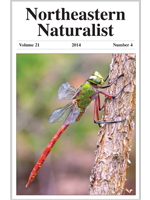Riparian landscapes are dynamic systems and exhibit considerable spatio-temporal variation in stream flow and physical composition of stream substrates that provide habitats for many species. We investigated genetic diversity and population genetic structure of Harperella nodosa (Harperalla; Apiaceae), a federally endangered semi-aquatic plant. We employed a unique study design that involved sampling at regional, stream, and fine scales in 3 riverine systems in Maryland and West Virginia. Using intersimple sequence repeats (ISSRs), we found high levels of genetic diversity at all scales and pronounced fine-scale genetic structure. Pairwise correlation between geographic and genetic distance was scale-dependent. This study illustrates that temporal monitoring and multiple-scale plans are essential for conservation management programs for Harperella.
How to translate text using browser tools
1 March 2015
Genetic Variability of Maryland and West Virginia Populations of the Federally Endangered Plant Harperella nodosa (Rose) (Apiaceae)
Whitney B. Smith,
Christopher T. Frye,
Ericka Veliz,
Shandi Hiebler,
Ryan C. Taylor,
Kimberly L. Hunter
ACCESS THE FULL ARTICLE

Northeastern Naturalist
Vol. 22 • No. 1
March 2015
Vol. 22 • No. 1
March 2015




